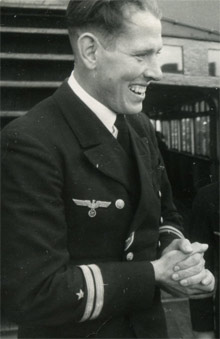German Industries and
the U-boat offensive
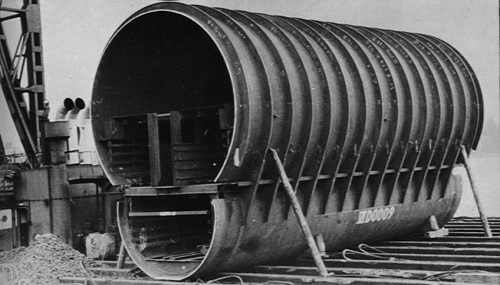
Pressure hull section of an XXI boat, built by Dortmunder Union, 1944
Component parts industry for submarine building
From its start at the beginning of the 20th century the German submarine building rested on industrial firms manufacturing the many component parts going into submarines. Within a few years separate production lines developed. These special production lines are the reason why for almost 100 years there have been firms in Germany, which possess a near-monopoly on certain component parts for submarines. To these belong for example the Allgemeine-Elektrizitäts-Gesellschaft (AEG, Berlin), Brown, Boverie & Co. (BBC, Mannheim) and the Siemens-Schuckert AG (SSW, Berlin) for electrical engines, the former Accumulatoren Fabrik AG (today VARTA/VHB, Hagen) for battery facilities, and also the Maschinenfabrik Augsburg-N?rnberg (MAN, Augsburg) for diesel engines.
Since the years before World War I until today the Zeiss works in Jena have supplied most the high-technology periscopes for the German submarines. As in the case of shipbuilding there is a tradition of many years of production and sale in the component parts industry and in international tranfer of submarine technology. At the start of the creation of a new submarine fleet by the Federal republic of Germany the Daimler-Benz and the MTU concerns joined the suppliers of engines for example, and the Akkumulatorenwerke Wilhelm Hagen KG in Soest, property of the Svedish Tudor Group, as the VARTA Batterie AG in Hagen again, those of the large battery facilities in the boats.
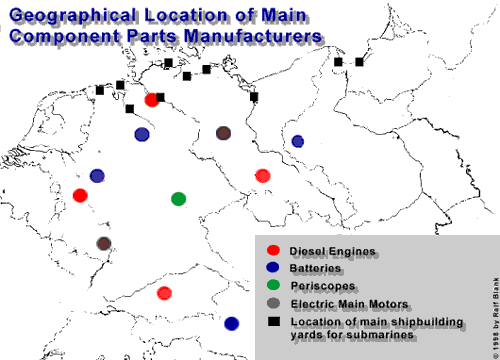
The steel industry in the Ruhr areas
A similar role was played by the German steel and steel construction industry, which was located mainly in the Rhineland and Ruhr areas. It supplied for example the plates of special steel for the pressure and outer hulls. Besides the large Krupp concern in Essen the Klöckner works in Duisburg and Hagen, the Gute-Hoffnungs-H?tte in Oberhausen, Thyssen in Dortmund and M?lheim as well as the Dortmund-Hörder-H?ttenverein supplies those components for the submarine building. For example the Krupp works in Essen produced torpedo tubes and gearings and some small firms in the Ruhr valley among Essen and Arnsberg manufacturing special anchor chains for submarines. All of these firms had an long tradition in the building of parts for submarines since the German empire.
New boats as "wonder weapons"
After the first submarine campain in the Atlantik was lost in summer 1943, the industrial shipbuilding was reformed under control of Albert Speer, the German minister of weapons and armament. With the designing and building of the prefabricated sectionalized Electro-boats XXI and XXIII between 1943/44 and 1945 the conventional shipbuilding methods was reduced and an turning point was reached. These newly designed types were characterized by greater submerged speed because large battery facilities and powerful electrical engines and a depth emergence capacity. The larger typ XXI was designed for operations on the high seas - in areas like the Atlantic and the small XXIII boats were for the North- and East Sea, the sea area along the British Isle and for operations in the Black Sea. All of these boats were also equiped with modern components like "Schnorchel", "Radar" and a better target-finding-system.
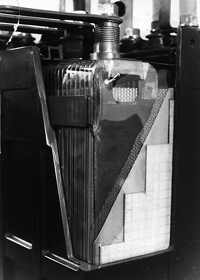 Left: Battery cell box, 44 MAL 740 used by type XXI submarines, 1944/1945
Left: Battery cell box, 44 MAL 740 used by type XXI submarines, 1944/1945
The new German supreme commander of the navy and former chief of the submarine fleet, Grossadmiral Karl Dönitz, believed that the newly "Elekto-Boote" had been the coming "wonder weapons" of the German navy in 1944, such as the flying bomb "V-1" and the jet fighters of the German air force or the rocket "V-2" and the tank "Königstiger" of the German army. But these ideas stayed only a dream, because Germany had lost the war since the Allied invasion in northern France in June 1944 and the soviet offensive in the areas of the German army group "Mitte" a few weeks later.
The massive strategic bombing of the allied air forces and the Allied advance into the "Reich" destroyed in the following month the rests of such mad ideas from German military and political personalities. In fact, the successes of the single type XXIII which was became only in operation at the beginning of 1945 was negligible.
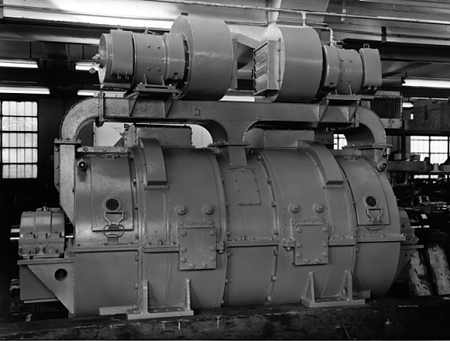
Electric Main motor "Hertha" of type XXI. Siemens-Schuckert AG, 1944
Increased Production
The process of section-building made possible a shorter production time of the submarines as well as the manufacturing of component parts by steel firms inland. The parts for the section 8 of XXI and the tower as well as the front section of XXIII boats were made for example by steel construction firms in the Siegen area south of Dortmund. Other firms in this secluded "bombproof" area were engaged in the manufacturing of control equipment, valves and instruments after 1943. But the building of these new boat-types made a considerable effort for the German industry in the last two years of the war, what produced many difficults in the technical, supply and organization sectors. Allied air attacks on the waterway-system on which the sections were transported to the shipbuilding yards and the destruction of the railroad traffic since autum 1944 reduced the output of these boats.
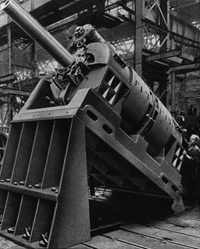 Left: Main electric motor UBM 4000 built by AEG, 1917
Left: Main electric motor UBM 4000 built by AEG, 1917
The German component industry was not only engaged in the supply of large U-boat types. Alltogether the building of midget submarines such as Bieber, Hecht, Seehund and Molch since summer 1944 needed a great deal of component parts. Beside these aspects the most important weapons of submarines, the torpedos, were also strong connected with the supply of component parts (batteries, boilers for fuel, rolling mill steel for the hulls or fuze pistols). For example the manufactors of batteries must also supply the operating fleet continuous. This was the reasion for a very difficult situation for those special industry like battery plants, which had a strong effort in World War II with reduced raw material such as lead, copper and particulary rubber for the battery boxes.
Slave workers in the German submarine program
In addition to the thousands and thousands of skilled workers and prisoner of wars in the industrial firms, since summer 1943 a great quantity of slave workers from German concentration camps were also employed at the submarine building yards and in the manufacturing of component parts such as batteries, engines and torpedos. For example close to the Viena and Hanover plants of the Accumulatoren Fabrik AG two large concentration camps of the KZ Neuengamme (for the Hanover plant) and KZ Mauthausen (for the Viena-Florisdorf plant) with over 1000 prisoners in each case was build up after summer 1943. The increase of the German submarines program in the spring of 1944 was connected and in close cooperation with the slave workers program of the SS in the concentration camp system. This is a dark aspect of armaments industries in Germany during 1943-1945.
Strategic bombing agains the submarine industry
During World War II the industrial firms manufacturing component parts for submarines were only in isolated cases a special target of the Allied bombing raids. Only the Accumulatoren Fabrik AG in Hagen, the diesel engines factories in Mannheim and Stuttgart were already planned to be attacked in the spring of 1941 as a targes of the "Atlantik-Directive" of British Air Ministry. In the spring and summer 1942 the British Bomber Command seek to destroy the engines factory of MAN in Augsburg, the Gottried Hagen Akkumulatoren Fabrik in Cologne (which was in fact no manufactor of submarine batteries!) and the Accumulatoren Fabrik AG in Hagen by sporadic raids with single two-engined Mosquito aircraft without an offensive character and success.
On 17 April 1942 the British Bomber Command-Chief Arthur Harris sent a small forces of 12 four-engined Lancaster aircraft to the submarine diesel engines factory of MAN in Augsburg under daylight conditions. The Bomber Command lost 7 aircraft as a result of this raid, but the damage in Augsburg was small. After the Cologne raid ("Thousand bomber raid") on 30/31 May 1942 the insignificant Gottfried Hagen battery works was also destroyed. The Allied supposed until end of war that these factory was in second importance of the manufacturing of submarine batteries, but that was not true (the factory produced mostly batteries for railway requirements). Since the British research facilities stated that there were no clue that the supply of submarine batteries was reduced, the allied target investigation teams thought that all products of the submarine component industry was an little sensitive target system and concentrated the following raids on the shipbuilding yards. As a result until the war the Allies underrated the German submarine industry consequently.
In November 1945 then the United States Strategic Bombing Survey stated that several air raids on both port and cities with factories of component parts, had effects on submarine production. The most important of these were the "Hamburg catastrophe" between 25 July and 2 August 1943 and two British area raids on 2 October 1943 and 2 December 1944 on the town of Hagen in the Ruhr area, the location of one of the leading factories of submarine batteries. The American investigation team further concluded in its report that for example the early destruction of the two most important battery factories in Hagen and Hanover would have weakened the submarine warfare at an early stage of the war, if it had not made it impossible. They stated further that large scaled bombing raids on these two battery plants between 1941 and in the spring of 1943 in close connection with attacks on sea would be the actual and powerfull strategy against the German submarines.
One occasion for these statement was the fact that not only the new boats must have batteries, but also the operational submarine fleet needed a great supply of batteries continuous, which was often destroyed on sea by Allied water bombing attacks and in emergence submerged operations. Permanent bombing raids against the steel industry were not effectiv in contrast to this but those factories engaged in diesel engines, electrical motors and periscopes, which was concentrated in few towns only, would be able to produce similar effect such as these against battery plants. The American study conclused that air raids against industrial firms of component parts should reach the second priority behind the most effectiv attacks against operational submarines at sea. The air raids on the shipbuilding yards which was favourited by the Allies in World War II produced in fact only little effects in the reduction of the output of submarines.
A different tradition
Plans for air raids against the German submarine industry in World War I It's most interest that the British Admiralty these facts already found out in World War I. Between 1916 and 1918 the Admiralty and the Royal Air Force planned long range raids against the Accumulatoren Fabrik in Hagen as soon against the steel works in Essen, Hagen and Duisburg. In 1917/18 four-engined Handley Page bombing aircraft should be prepared for air raids against top-priority targets like Hagen, to damage there the most important submarine battery factory. The British Admiralty hoped for that these raids could be able to reduced the repercussions of the unrestricted submarine warefare, which was declared by the German emperior in the spring of 1917. The insuffizient technical equipment and the slight personal training in the British air forces in World War I was not able to realized these plans, because the small sized town of Hagen was situated in a deep valley and the cramped development of the Accumulatoren Fabrik had no suitable visual aiming points for both a night or day raid. In the spring of 1919 the Royal Air Force was schedule to open a close air offensive against the German industrial areas and particulary against the submarine industry. In November 1918 the Great War was over and the plans were vanish into the archives.
Article kindly written and provided by Ralf Blank, check out his page (in German).
Editing: Gudmundur Helgason
